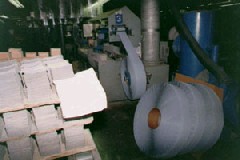
Enveloping machine
|
Enveloping involves placing a plate (usually positive),
either automatically or manually, within
porous membranes. The major sources of exposure in this process
result from lead oxide being released when the plates are handled incorrectly, such as resting them against the body
or handling them in unventilated areas.
|
|
Potential Sources of Exposure
- Lead oxide may become airborne due to workers improperly handling plates
at the feed and discharge ends of enveloping machines as well as from the bellows effect when
handling unsealed envelopes.
- Exposure to lead may occur when the lead oxide that has accumulated on equipment, racks,
and floors becomes airborne.
-
Lead dust may become airborne when workers improperly handle scrap plates.
- Lead may contaminate clothing when a worker leans against contaminated equipment.
- Increased exposure to lead oxide may occur when tamping plates in unventilated areas, such as the rack, creates puffs of lead dust.
Possible Engineering Controls
- Use local exhaust ventilation, such as a grating or a perforated plate tamping stand that is equipped
with downdraft and side-draft ventilation (Figure 4).
- Enclose and ventilate equipment.
- Use a ventilated scrap barrel.
 Scrap
Handling Barrel/Drum Exhaust Hood Scrap
Handling Barrel/Drum Exhaust Hood
- Provide a vacuum drop at the workstation.
- Use a rotating base for placing pallets of plates so employees do not
have to reach across.
- Use a laminar
flow (supplied-air) island over operators workstation.
Possible Work Practice Controls
- Tamp plates carefully over ventilated work station.
- Do not bang plates excessively while tamping.
- Keep open ends of envelopes away from the face.
- Handle groups of plates with hands only rather than leaning them against the
stomach.
- Wear an apron (Figure 2).
- Place, do not throw, defective plates into a scrap barrel.
- Cover drums with a plastic bag before removing them from the area.
- Seal all doors, windows, and other openings on the enveloping machine.
- Perform plate parting using local exhaust ventilation (downdraft or side-draft), and not while the plates
are moved from the pallets to the enveloping equipment.
- Do not store plates on ventilated tamping stands.
- Provide adequate PPE, a change of clothes, and shower rooms (see OSHA Lead Requirements for PPE, Housekeeping, and Hygiene Facilities).
- Maintenance:
- Ensure that local exhaust ventilation is working properly.
- Prevent cross drafts.
- Use plastic bags in catch receptacles to facilitate removal without dust generation.
- Housekeeping:
- Vacuum the separator boards, workstation, and adjacent areas.
- Use dust suppression techniques, such as keeping the floor wet, using
dust suppression compounds, or vacuuming.
- Ensure plate trays are vacuumed clean.
|
|
|
|

